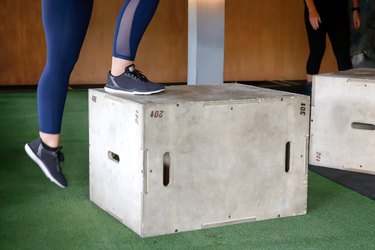
Plyometrics involve power jumping, repetitive bounding and quick force production. When your muscles eccentrically contract, or shorten, then immediately stretch and lengthen, they produce maximal power ideal for athletic situations.
Plyometrics are ideal for athletes or people looking to improve muscular power, speed and strength. They also help facilitate weight loss and help tone and define your muscles. However, like any type of exercises, there are pros and cons of plyometric training.
Video of the Day
Video of the Day
Read more: Plyometric Exercises for Boxing
Boost Power and Speed
Plyometrics were originally designed for power athletes like sprinters, football players and gymnasts. Muscles achieve maximum power during eccentric contractions, or muscle lengthening.
When you immediately follow an eccentric contraction with a concentric — or muscle-shortening — contraction, your muscle produces a greater force. This is called the stretch-shortening cycle. One of the many advantages of plyometric training is decreased time between your eccentric and concentric contractions and improved muscular speed and power.
Build Your Strength
With power and speed come muscular strength gains. Plyometrics can improve strength in both your upper and lower body. Plyometric training examples for the lower body include tuck jumps, squat jumps, box jumps and depth jumps.
The goal of these jumps is to get higher, utilizing your leg strength to improve the height of your jump. Upper body plyometrics include clapping pushups, medicine ball chest press throw and overhead throws. These help improve strength in your upper body.
Benefits of Plyometric Training
Benefits of plyometric training include torching calories, increasing muscles strength and improving power with explosive movements such as jumping or hitting a ball. Plyometric exercises require a lot of energy because they are highly intense. They utilize the whole body and activate most muscle groups, therefore burning many calories in a single session and aiding in weight loss.
Repetitive landing causes your entire leg muscles to contract, helping to improve overall tone and definition. Plyometrics combine strength training and cardiovascular exercise, allowing you to "kill two birds with one stone."
Disadvantages of Plyometrics
The only real disadvantage to plyometric training is the high risk of injury. Like all exercise and sports, plyometric training is a continuum, where beginners start with light exercise and low volume and then gradually progress with gained strength.
The repetitive jumping and bounding can cause stress on the joints. Do not engage in plyometrics if you have arthritis or joint issues, unless cleared by your doctor. If you are untrained, risk of strains is elevated, because the muscles surrounding your joints are weaker and may not give you the support you need.
Read more: List of Exercises for the Plyometrics P90X
Guidelines for Safety
According to a November 2015 study published by the International Journal of Sports Physical Therapy, plyometric training should be progressed over time to help prevent injury from overtraining. Begin with low volume — 50-foot contacts per training session — and work up to a high volume of 200 or more foot contacts in one session.
Allow adequate rest time of 48 to 72 hours between plyometric training sessions to help prevent injury. Err toward longer rest periods if you are new to this type of exercise. Before beginning, do a 10-minute light cardiovascular warmup to increase blood flow to your muscles and help prevent injury.